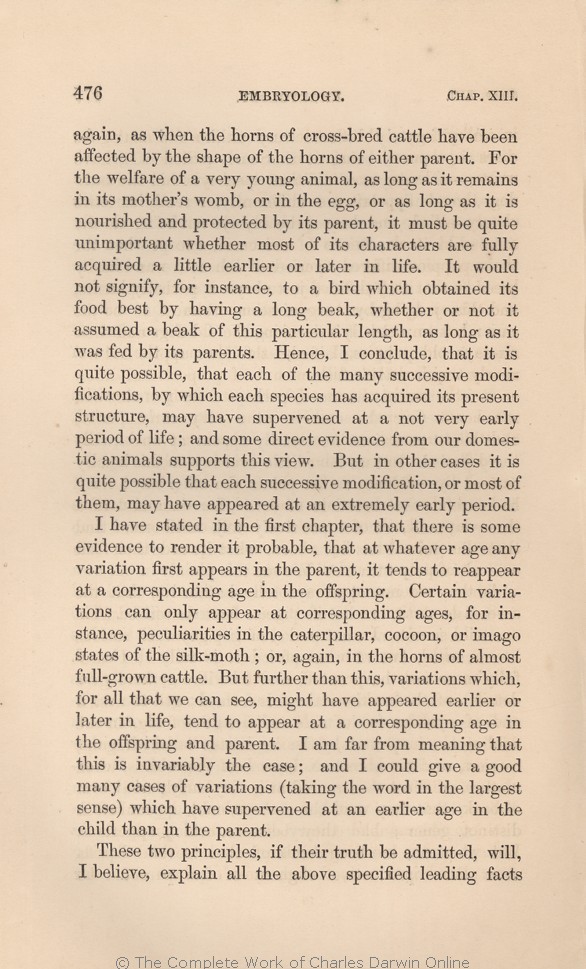again, as when the horns of cross-bred cattle have been affected by the shape of the horns of either parent.
For the welfare of | For the welfare of 1859 1860 1861 1866 |
| It deserves notice that it is of no importance to 1869 1872 |
| mother's 1859 1861 1866 1872 | | mothers 1860 1869 |
| womb, 1859 1860 1861 1866 | | womb 1869 1872 |
| it 1859 1860 1861 1866 | | whether 1869 1872 |
| must 1859 1860 1861 1866 | | most 1869 1872 |
| be quite unimportant whether most 1859 1860 1861 1866 |
| OMIT 1869 1872 |
| fully 1859 1860 1861 1866 | fully 1869 1872 |
| best 1859 1860 1861 1866 | best 1869 1872 |
| long 1859 1860 1861 1866 | | much-curved 1869 1872 |
| beak, 1859 1860 1861 1866 1869 | | beak 1872 |
| it assumed 1859 1860 1861 1866 |
| whilst young it possessed 1869 1872 |
| particular length, 1859 1860 1861 1866 | | shape, 1869 1872 |
|
|
I have stated in the first chapter, that
there is some evidence to render it probable, that | there is some evidence to render it probable, that 1859 1860 1861 |
| there is a large body of facts rendering it probable, that 1866 |
| OMIT 1869 1872 |
| any 1859 1860 1861 1866 | | a 1869 1872 |
| reappear 1859 1860 1861 1866 1869 | | re-appear 1872 |
| ages, 1859 1860 1861 | | ages; 1866 1869 1872 |
| silk-moth; 1859 1860 1861 | | silk-moth: 1866 1869 1872 |
| horns of almost full-grown 1859 1860 1861 1866 |
| full-grown horns of 1869 1872 |
| cattle. But further than this, variations which, for all that we can see, might have appeared earlier or later in life, tend to appear at a corresponding age in the offspring and parent. 1861 |
| cattle. 1859 1860 1866 1869 1872 |
| I am far from meaning that this 1861 |
| But further than this, 1859 1860 1866 |
| But 1869 1872 |
| is invariably the case; and I could give a good many cases of variations (taking the word 1861 |
| variations which, for all that we can see, might have appeared earlier or later in life, tend to appear at a corresponding age 1859 1860 1866 |
| variations, which, for all that we can see might have appeared either earlier or later in life, likewise tend to appear at a corresponding age 1869 |
| variations, which, for all that we can see might have first appeared either earlier or later in life, likewise tend to re-appear at a corresponding age 1872 |
| largest sense) which have supervened at an earlier age in the child than in the 1861 |
| offspring and 1859 1860 1866 1869 1872 |
| 1 blocks not present in 1861; present in 1859 1860 1866 1869 1872 | | I am far from meaning that this is invariably the case;
and I could give a good many
cases of variations (taking the word in the largest sense) which have supervened at an earlier age in the child than in the parent.
|
|
|
These two principles,
if their truth be admitted, will, | if their truth be admitted, will, 1859 1860 1861 1866 |
| namely, that slight variations generally appear at a not very early period of life, and are inherited at a corresponding not early period, explain, as 1869 1872 |
| explain 1859 1860 1861 1866 | explain 1869 1872 |
|









